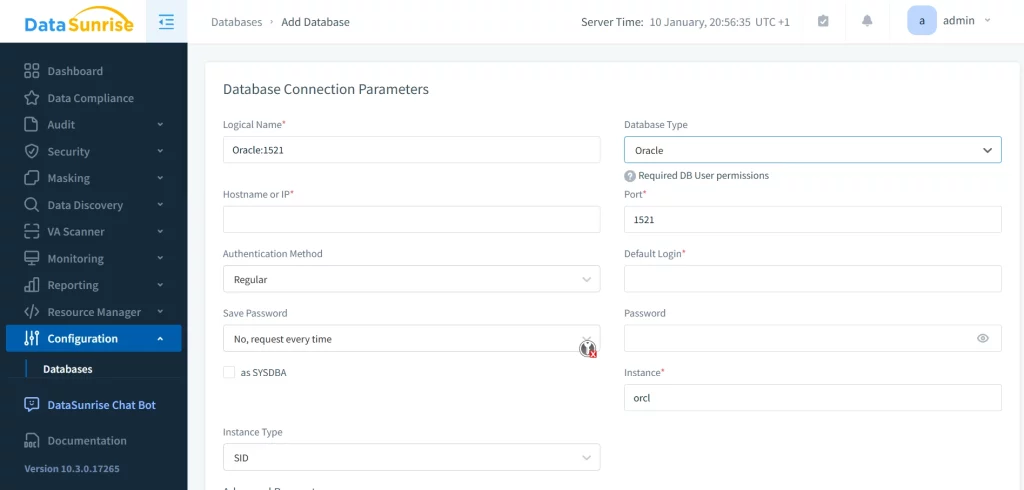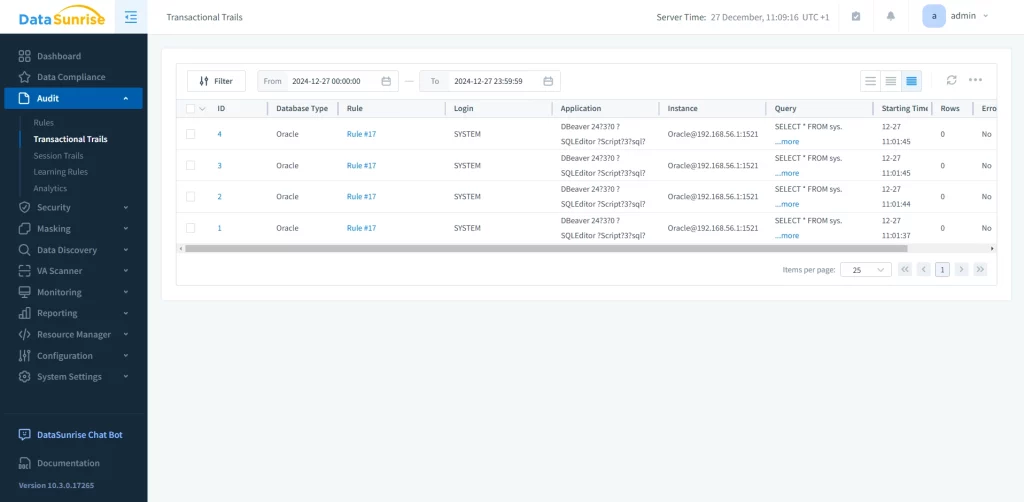
Oracle Database Activity History
Introduction to Oracle Database Activity History
In the realm of database management, tracking database activity is crucial for ensuring security, compliance, and optimal performance. Oracle, a leader in database solutions, provides robust mechanisms to capture and analyze database activity history. This article delves into Oracle’s native capabilities for tracking database activity, demonstrates how to configure these features, and outlines best practices for leveraging them effectively.
1. Native Database Example: Oracle’s Built-In Database Activity Tracking
Oracle offers several native methods to track database activity, each designed to meet specific monitoring and compliance needs. Below are the primary types of database activity tracking available in Oracle:
Standard Database Activity Tracking
Standard tracking captures basic SQL operations such as SELECT, INSERT, UPDATE, and DELETE. This method provides a foundational level of monitoring but may lack granularity for advanced security or compliance requirements.
Enabling Standard Database Activity Tracking:
To enable standard tracking, use the following SQL commands:
ALTER SYSTEM SET audit_trail = DB, EXTENDED SCOPE = SPFILE;
SHUTDOWN IMMEDIATE;
STARTUP;- This configures Oracle to log database activities within the database itself.
- The
EXTENDEDoption ensures that both SQL statements and bind variables are captured.
After executing queries, you can view the logs in the DBA_AUDIT_TRAIL table.

Fine-Grained Database Activity Tracking
Fine-grained tracking allows for more specific monitoring, such as auditing access to sensitive data like high-value transactions or personally identifiable information (PII).
Enabling Fine-Grained Tracking:
To audit access to high-salary employees, use the following code:
BEGIN
DBMS_FGA.add_policy(
object_schema => 'system',
object_name => 'EMPLOYEES',
policy_name => 'audit_emp_access',
audit_condition => 'SALARY > 100000',
audit_column => 'SALARY',
handler_schema => NULL,
handler_module => NULL,
enable => TRUE
);
END;- This creates a policy on the
EMPLOYEEStable, logging any access whereSALARYexceeds $100,000. - Results can be viewed in the
DBA_FGA_AUDIT_TRAILtable.

2. Configuration of Oracle Database Activity History
While Oracle’s native tracking capabilities are powerful, integration of third-party solutions like DataSunrise can drastically improve their effectiveness. Here’s how to configure Oracle Database Activity History in DataSunrise:
Step 1: Integration with Oracle Database
Ensure that your Oracle Database instance is properly configured to log activities. This involves setting up the appropriate audit trails and policies. After this you can proceed to adding Oracle Database instance to DataSunrise:

Step 2: Setting Up Audit Rules
DataSunrise allows you to define custom audit rules for specific database activities. For example, to log every system user action on the EMPLOYEES table:
- Navigate to the Audit Rules section in Oracle.
- Create a new rule with the following parameters:
- Object Schema:
system - Object Name:
EMPLOYEES - Action:
SELECT,INSERT,UPDATE,DELETE - Condition:
SALARY > 100000
- Object Schema:
Step 3: Centralized Reporting
DataSunrise aggregates logs from multiple databases into a single interface, simplifying analysis and reporting. Access the Transactional Trails tab to review all audited activities.

3. Best Practices for Oracle Database Activity History
To maximize the effectiveness of Oracle Database Activity History, follow these best practices:
1. Define Clear Auditing Policies
Establish clear policies for what database activities need to be tracked, such as access to sensitive information or schema changes. This ensures that auditing is focused and efficient.
2. Use Fine-Grained Auditing for Sensitive Data
For high-value or sensitive data, implement fine-grained auditing to capture detailed access logs. This helps in detecting unauthorized access and ensuring compliance.
3. Enable Real-Time Monitoring
Use Oracle’s native features to monitor database activities in real time. This allows for immediate detection and response to potential security threats.
4. Regularly Review Audit Logs
Schedule regular reviews of audit logs to identify patterns, anomalies, or potential security issues. This proactive approach helps in maintaining database security and performance.
5. Integrate with Compliance Frameworks
Ensure that your auditing practices align with regulatory requirements such as GDPR, HIPAA, and PCI DSS. Use centralized reporting tools to simplify compliance reporting.
6. Train Database Administrators
Provide training for database administrators on Oracle’s native auditing features. This ensures that they can effectively configure and manage database activity tracking.
4. Conclusion
Oracle Database Activity History is a powerful tool for tracking and monitoring database operations, ensuring security, compliance, and optimal performance. By leveraging Oracle’s native capabilities—such as Standard and Fine-Grained Auditing—organizations can maintain robust database management practices.
By following best practices—such as defining clear auditing policies, enabling real-time monitoring, and regularly reviewing audit logs—organizations can maximize the benefits of Oracle Database Activity History. This ensures that databases remain secure, compliant, and optimized for performance.
If you wish to get a detailed personal review of DataSunrise’s features, you can schedule an online demo. If you instead, prefer to explore features by yourself, proceed to the download. Here you’ll be able to get the latest distribution of DataSunrise for any major Operating System.
